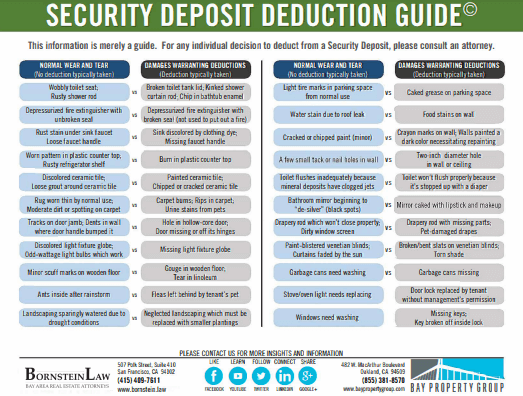Let’s talk about damages, unpaid rent, and what can be recovered in civil courts

Now nearly midway into 2024, the rental housing community should be aware of new laws and rent registries to comply with. If not, it wasn’t because of any lack of outreach on our part. Yet one law we haven’t mentioned thus far is California Senate Bill 71.
Until recently, plaintiffs commencing a lawsuit in small claims court could only sue for up to $10,000. This dollar amount has been bumped up to $12,500 in small claims court and $35,000 in limited civil cases. For COVID-related rent debt accrued during certain periods, the amount housing providers can seek is unlimited.
Perhaps this incremental dollar increase amount is little solace for landlords with tenants who have inflicted thousands of dollars worth of damages in their rentals, much more than what can be recouped through security deposit deductions.
Download our security deposit guide »
Insecurity in security deposits
The news does not get any better for housing providers after a new state law (AB 12) limits security deposits to the equivalent of one month’s rent whether furnished or not, with certain exceptions carved out for small landlords.
While the law intends to open more doors to more Californians who are seeking housing but cannot afford to put down two or three months' rent, we predict it will have the opposite effect in many cases. Risk-averse.
The concern we have is why housing providers would have to sue tenants up to $12,500 in the first place.
When we have to deal with thousands of dollars worth of damage, we question the diligence of the landlord or their property manager in the proper selection of a tenant. Much damage and heartburn could have been avoided through excellence in tenant screening. This is a core aspect of landlording and property management, as we discussed in this past webinar.
But let’s say the damage is already done. What to do next? This engenders more questions.
First and foremost, owners and property managers should document any damage as soon as they become aware of it by taking photographs, taking copious notes, and perhaps getting witness accounts.
We’ll need to ascertain how the damage occurred, whether due to negligence, normal wear and tear, or an unavoidable accident.
Has the tenant committed “waste?” This legal term generally refers to actions or inactions by the tenant that negatively impact the property’s condition and value. Some examples:
-
Unauthorized Renovations: The tenant makes significant alterations to the property without the landlord's permission, such as adding or removing walls, changing plumbing fixtures, or installing permanent structures in the yard.
-
Intentional Damage: Deliberate actions that damage the property, such as punching holes in walls, breaking windows, or damaging appliances and fixtures.
-
Illegal Activities: Conducting activities that are illegal and cause damage to the property, such as manufacturing illegal drugs, which often involves chemical spillage and structural modifications.
-
Neglect of Maintenance: Failing to report or address maintenance issues that then lead to greater damage, like ignoring a leaking roof leading to water damage and mold growth.
-
Poor Housekeeping: Allowing the property to become excessively dirty or cluttered, which can attract pests or lead to long-term issues with mold and odors.
-
Failure to Prevent Damage: Not taking reasonable steps to prevent damage during adverse conditions, such as leaving windows open during a rainstorm, which can cause water damage to interiors and furnishings.
If the cause of the damage falls squarely on the tenant, we could formally demand that they pay for the cost of repairs or if not, be subject to eviction. Landlords should obtain estimates for repairs to understand the cost of fixing the damage and use this as evidence if there are disputes that arise about the severity of the damage.
Whenever we encounter acts of nuisance, the question always becomes whether the tenant’s behavior is curable or not.
Some acts are so egregious, some damage so substantial, that the tenant should not be afforded the opportunity to correct it. Having managed landlord-tenant relationships for over 3 decades, Bornstein Law has a good feel of what is considered curable and what cannot be cured and advise clients accordingly on how to proceed.
If the transgression is curable, keep in mind that in some jurisdictions like San Francisco and Oakland, the landlord must send a ten-day letter to the offending tenant giving them extra time to fix the underlying behavior or condition of the property. Only afterward can we proceed with a 3-day notice to quit.
What awaits landlords now are the carefully choreographed steps of the eviction process.
We often like to share this handy, one-page PDF that illustrates this process. Although there are slight local nuances, the rules have fundamentally remained unchanged over the years.
The landlord has recovered possession of the unit. The tenant is removed, but owes a lot of money in excess of the security deposit. Now what?
We were intrigued to come across an article, entitled, "Where did all the small claims cases go?" and there was no definitive answer because although small claims courts are a widely used apparatus to resolve disputes and are popularized by shows like “Judge Judy,” it is also one of the least studied.
Yet one of the most compelling reasons offered why these “people’s courts” are on the decline is the prevalence of arbitration agreements between businesses and their customers. These arbitration clauses often siphon off cases that would have gone to small claims court in the past. We can relate.
95% of all eviction cases are settled because our clients want to resolve the matter as quickly, efficiently, and inexpensively as possible. As part of these settlements, we oftentimes make concessions like forgiving rent debt or agreeing not to sue for property damages. So, in exchange for recovering possession of the unit, clients agree not to elongate the matter; when we reach a settlement agreement, the matter cannot be aired out in court later if the settlement includes a release of claims arising from the tenancy.

The grand lie of politicians to justify eviction moratoriums and crafting legislation in response to the public health crisis.
Lawmakers were all too quick to point out that when moratoriums were in effect, COVID-related rent debt was deferred, it was not waived; tenants still owed the rent arrears. But did anyone believe at the time that landlords would ever be made whole?
Although legislators unshackled small claims courts and allowed housing providers to file lawsuits over $10,000, they also erected many barriers to using small claims courts. For example, the ability of housing providers to recover a mountain of rent debt was dependent on participation by both landlords and tenants in a dysfunctional rental assistance program plagued with glitches and inefficiencies.
The Contra Costa County Bar Association published an informative article on all of the roadblocks that stand in the way of housing providers looking to chase rent debt. View it here.
Our takeaways and informed advice.
An ounce of prevention is worth a pound of cure. By selecting excellent tenants, housing providers can avoid nonpayment of rent cases and substantial property damage. While technology is a useful tool in technology screening, it is not a panacea. There is no substitute for old-fashioned personal sleuthing, contacting references, and meeting the rental applicant.
Housing providers and/or their property managers must be eyes and ears of their property and try to identify damages early on. We want to create a culture that makes it easy and friendly for tenants to report problems before they fester and the property atrophies further.
We need to isolate some bad actors - those tenants who grossly neglect their surroundings, if not intentionally damage the unit. In these cases, there is a clear sense of urgency to remove them. Every case is different and is best evaluated with an attorney who practices landlord-tenant law on a daily basis.
Call us cynical, but we are not all that optimistic that rent debt and property damages can be recovered. Even if a judgment is obtained in small claims or superior courts, the judge will not invert the defendant upside down and shake money out of their pockets in the courtroom; collecting the money owed is a whole different matter yet to unfold. We do, however, have some creative ways to collect debt such as threatening the filing of a 1099-C to create a taxable event for someone who is delinquent on the rent and that rent debt is forgiven.
To continue the conversation, share some more details about your situation and we can have a more tailored discussion on how to accomplish your goal.


